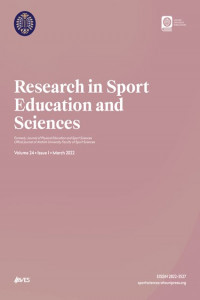ON İKİ HAFTALIK DANS EĞİTİMİNİN İLKÖĞRETİM BEŞİNCİ SINIF ÖĞRENCİLERİNİN EL-GÖZ KOORDİNASYONLARI VE KEAKSİYON SÜRELERİNE ETKİSİNİN DEĞERLENDİRİLMESİ
Bu çalışmanın amacı üç ay ve haftada bir gün bir ders saati yapılan dans çahşınasının ilköğretim beşinci sınıföğrencilerinin el-göz koordinasyonlan ve reaksiyon sürelerine etkilerini belirlemektir.Çalışmaya (11-12 yaş) arasında 26 denek ve 26 kontrol grubunda olmak üzere toplam 52 öğrenci katılmıştır.Bu öğrenciler gönüllü olanlar arasından rastgele seçilmiştir. Çalışmada deuek grubuna haftada bir gün birders saati vals ritimlerindeu oluşan hareketlerle çalışma yaptınlırken kontrol grubu günlük aktivitelerinedevam etmiştir.Ön test ve son test ölçümlerinin gruplarlU kendi içindeki farklılıklannın belirlemnesinde eşleştirilmiş t testikullanılmıştır. Gruplar arasındaki farklılıklannın incelenmesi için bağımsız t testinden yararlanılmıştır.ist.atistiksel analizler SPSS paket programında değerlendirilmiş ve anlamlılık düzeyi p < 0.05 olarak kabuledilmiştir.Yapılan istatistik çalışmalann sonucuna göre; reaksiyon süreleri eşleştirilmiş t testi deney ve kontrol grububasit reaksiyon süresi ön-son test değerleri arastnda deney grubunda anlamlı fark bulunamazken (P>O.OS)kontrol grubunda anlamlı farklılık bulunmuştur (P<O.OS). Ses-ışık reaksiyon süresi ön-son test değerlerindedenek grubunda anlamlı fark (P<O.OS) bulunurken kontrol ses-ışık ve deney-kontrol çoktan seçmeli reaksiyonsüresi ön-son test değerlerinde antamlı fark bulunamanuştır (P>O.05).EI-göz koordinasyonu eşleştirilmiş t testi bulgulanna göre; deney grubunun el-göz koordinasyonu süredeğerleri ve hata sayılan ile kontrol grubu hata sayılan ön-son test değerleri arasında anlamlı farklılık(P<O.05) bulunurken kontrol grubunun süre değerleri arasında anlamlı farklılık bulunamarnıştır( P>O.05 ).Anahtar Kelimeler: Reaksiyon süresi, el-göz koordinasyonu, dans, çocuk ABSTRACTThe aim of this study was to determine the effeets of dans training applied during twelve weeks~ one hour aweek on hand-eye coordination and reaction time of the elementaıy five class students.In this study attended 52 students aged between i 1 to i 2 years old were divided as the subject and controlgroups which eonsisted of 26 persons each. This students randomly selected among volunteer students. inthis researche, conlrol group lasted dailly activities while subject group was trained with movements ofconsist ofwaltz's rhythm.The differences between the pre and post tests of the groups were found by using compare t- test.Independent t- test has been used for comparing the differences between the groups. SPSS program has beenused to analyze the studyand it has been accepted p< 0.05 for significance level.According to paired samples t test's results; basic reaction time was not found significant for experimentgroup (P>D05) while basic reaction time was fouud sıgnificant P<005) for control group. While auditoıy andvisual reaction time was found significant (P<005) for subject group, control audiıory and visual reactiontime and experiment-control groups multiple-choice reaction time pre-post tests values were not found anysigıı ificant.According to hand-eye coordination paired samples t test [ındings; hand-eye coordination time values anderror numbers of subject group and error nurnbers of control group were found signjficant difference(P<QOS)between pre-post test values while hand-eye coordination time value of control group was not foundany significance (P>005) between pre-post test.Key Word: Reaction time, Hand-Eye Coordinaıion, Dance, Cllild.
Anahtar Kelimeler:
Reaksiyon süresi, el-göz koordinasyonu, dans, çocuk
- Başlangıç: 2020
- Yayıncı: Atatürk Üniversitesi
Sayıdaki Diğer Makaleler
Fatma ARSLAN, Gökhan BAYRAKTAR, Seleen AKDOĞAN
Orcan MIZRAK, Dursun KATKAT, İ. Fatih YENEL
İbrhim CİCİOĞLU, Salih SUVEREN
Fatma Çelik KAYAPINAR, Meral KÜÇÜK YETGİN, Aytekin SOYKAN, Erkan ÇALIŞKAN
